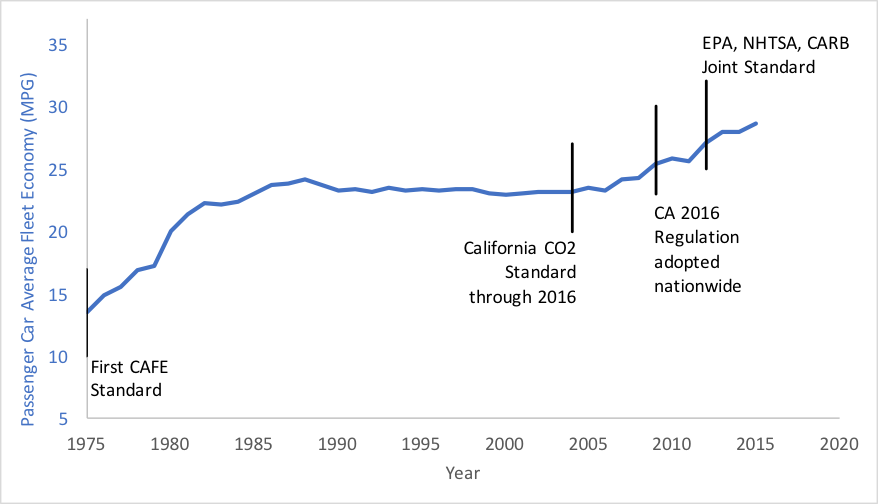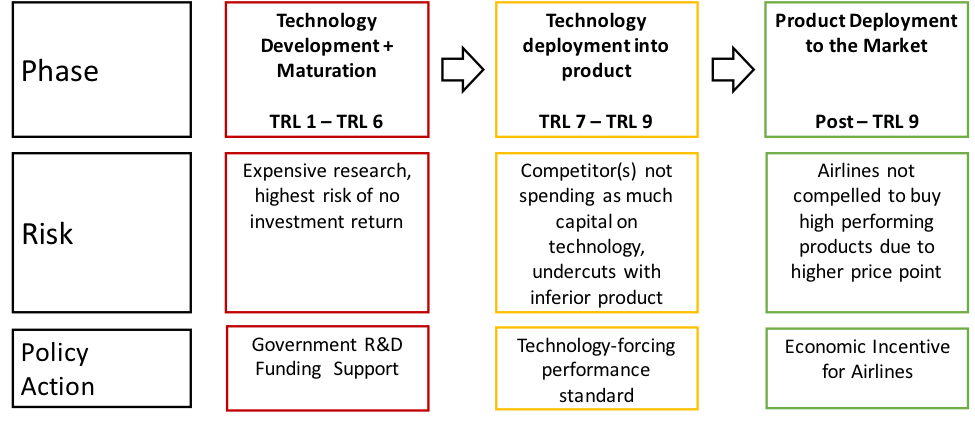Maximizing aircraft fuel efficiency: Back to the drawing board
Blog
Maximizing aircraft fuel efficiency: Listen to the experts
The fifth and final installment in a series featuring interviews with experts who worked with the ICCT on our cost assessment of near- and mid-term technologies to improve new aircraft fuel efficiency. The aim of the series is to highlight the potential fuel efficiency improvements of “clean-sheet” aircraft designs, to give a sense of how they influence the fuel efficiency trends in general, the risks that come with them, and, most importantly, what might be done to encourage them.
Over the past few weeks we’ve posted interviews with four of the experts in aerospace technology and commercial aviation from the technical advisory group who helped us with the research for our aviation fuel efficiency technology assessment last year. (See links to the older posts in this series at right.) Looking back, a theme stands out: risk. All these experts agree that one of the key challenges faced by engine and airframe manufacturers in developing fuel-efficient products is the looming risk that their significant investment will not pay off. After all, they are in the business of making profits for their shareholders. The more this risk is lowered, the better the chance that we will see a much-needed improvement of aircraft fuel efficiency. In this final post of the series, we explore ways to lower the risk faced by these risk-averse industry players.
Technology deployment into commercial aircraft comes in three phases: technology development and maturation, technology adoption into product, and product deployment into the market. The first phase generally ranges from Technology Readiness Level (TRL) 1 to TRL 5 or 6—prototype demonstration in a relevant environment (e.g. laminar flow on wings). Technology adoption into product is where a technology gets incorporated into an airplane or engine, which ranges from TRL-6 or 7 to TRL-9—marked by type certification. This is the phase in which, usually, an aircraft manufacturer takes over from a research organization like NASA and develops an aircraft in-house incorporating the technology. For example, laminar flow on nacelle is at TRL-9. The final phase starts after TRL-9, or certification, and extends out to the end of production lifetime, capturing the period during which a technology diffuses through a manufacturer’s complete product line. For example, the high-pass-ratio turbofan engine, which was first deployed by Boeing in the late 1960s on its 747 aircraft, wasn’t fully integrated into all Boeing aircraft families until the mid-1980s on the 737. All type-certified aircraft, until the day it ceases production, are included in this last phase.
Based on the interviews presented in the previous posts, it’s possible to identify one general policy action in each phase that would lower the risk faced by manufacturers and increase the likelihood of technology adoption.
Technology development and maturation: Research and development support
Direct government involvement in technology development, through institutions like NASA, and funding support for research takes the financial risk off the manufacturers and plays a crucial role in making fuel-efficient technologies available for adoption. Mike Benzakein, now director of the Propulsion and Power Center at Ohio State University and formerly in charge of developing the CFM56 and GE90 engines at GE, believes that electric propulsion is the future of aviation and that to make this happen the U.S. federal government “needs to support financially by funding work both in university and industry.”
In fact, many technologies on commercial aircraft originated in NASA’s laboratories and wind tunnels. The Environmentally Responsible Aviation (ERA) project completed recently, for example, developed and demonstrated technologies that could “cut airline fuel use in half, pollution by 75 percent and noise to nearly one-eighth of today’s levels.” Fay Collier, NASA ERA’s project manager, reiterated the need for “increased government investment in technology maturation and demonstrator that would make these technologies less risky and more adoptable for airframe and engine manufacturers.”
Every dollar invested in NASA generates $10 in returns to the economy. With that kind of return on investment, it makes sense for governments around the globe to invest in aerospace technology development and maturation, through organizations like NASA and the Japan Aerospace Exploration Agency (JAXA) and programs like Clean Sky in Europe. This level of support and collaboration between these organizations and industry, should be maintained and even increased to ensure the continuation of technology development in the sector.
Technology adoption into product: Implement technology-forcing performance standards
Correctly designed and implemented, a performance standard can act as a stimulant to innovation and technology adoption. A good example is the automotive industry in the United States. The Corporate Average Fuel Efficiency Standard (CAFE), first implemented in 1975 by the Department of Transport’s National Highway Traffic and Safety Administration (NHTSA), spurred a dramatic increase in average fleet economy over the first twelve years of the CAFE program—though high fuel prices also had an effect, the CAFE mandate was more important. New-car fuel economy in the US then stagnated between 1985 and early 2000, because the CAFE standard did not require further improvements from industry. When the stringent California greenhouse gas (GHG) standard was adopted by twelve states representing one-third of the US market in 2004, followed by adoption of a similar national standard by the US Federal government in 2009, we saw a renewed uptick in fuel economy.
Figure 1. Historical passenger car fuel economy and regulatory milestones in the U.S.
Meanwhile, in the aviation sector, the only policy related to fuel efficiency, the International Civil Organization (ICAO)’s new aircraft CO2 emissions standard, is not expected to reduce emissions further than what is already happening in the business-as-usual scenario, even if it’s implemented by all ICAO’s member states. This technology-following, instead of technology-forcing, standard cannot be expected to promote revolutionary fuel-efficiency improvements in the global fleet like that of the passenger vehicle in the US.
“The government should judiciously set the bar high enough so that the standard is forcing adoption of technology in a responsible way. Not too high that the risk becomes too extreme and stifle innovation, but not too low that technology suppliers become complacent,” as Stanford’s Juan Alonso put it to us. In addition, a technology-forcing standard may guarantee market demand for high-performing products and ensure that competitors cannot undercut high performers by offering cheaper, inferior products.
Product deployment into the market: Economic incentives for airlines
Even after successfully certifying their products, engine and aircraft manufacturers still face the risk that their products will not sell well enough to return their investment in product development. Professor Alonso also points out that economic incentives also exist within the industry. “Companies exist for benefit of shareholders for the long term. . . . Being more aggressive in increasing fuel efficiency is not just corporate responsibility but good for the bottom line of the shareholders.” However true this statement is, the success of an aircraft type is often measured by the number of aircraft sold. Economic incentives aimed towards the buyers would give that nudge needed by airlines or aircraft financiers to purchase more fuel-efficient aircraft instead of possibly cheaper existing products, thus securing demand of high-performing products.
Rich Golaszewski, executive vice president of GRA, Inc., thinks that the government should provide this economic incentive, by applying a “higher tax on fuel that would also provide incentives to use less fuel.” He added that as far as economic incentive goes, “tradable emission credits (via an auction) offer the best solution, but setting up working emissions credit markets has been problematic.”
A handful of fiscal incentives for airlines to use less fuel (and therefore buy more fuel-efficient aircraft) exist today. State-specific jet fuel taxes in the US and the EU Emissions Trading System (EU ETS) are a couple examples. But more could be done—for instance, charging operational fees based on fuel performance, just like existing airport charges based on gross weight, NOx emissions, noise performance, or all of the above (examples here, here, and here).
Aviation’s carbon footprint is rapidly increasing, and forecasts are that it may quadruple in the next few decades. Implementing advanced fuel-saving technologies onto aircraft has become an urgent priority. It’s clear that market forces alone are not enough to drive a rapid fuel efficiency improvement. The general policy actions tuned to different phases of technology development noted above (and see Figure 2) could give a much-needed boost to aircraft fuel-efficiency improvement, and might just help the industry meet the fuel-burn goals set by ICAO. The experts certainly think so.
Figure 2. Aircraft technology deployment phases, risk associated with each one, and policy actions.


